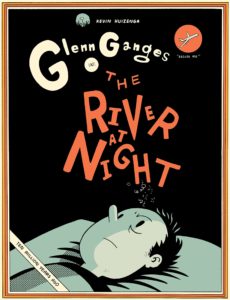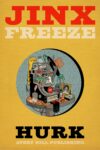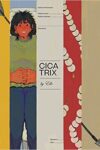
[Drawn and Quarterly; 2019]
A series of dashed parallel lines running across a page can texture a two-dimensional space. When the dashes at the bottom of the page taper into shorter dashes toward the top, the page becomes a plane, receding toward a horizon. It’s a modest effect, but with it two dimensions become infinite. At a time when history-altering acts take on an almost mundane insignificance, comics artist Kevin Huizenga’s The River at Night makes thought, banal and half-remembered quotidian thought, a moving drama of consciousness.
It’s fair to talk of The River at Night as a complete narrative arc, rather than a series of comics (though it can be read as that too). It centers on Glenn Ganges, a returning character in Huizenga’s comics, and what happens in his mind over the course of a day. Glenn’s flights of consciousness live in dialogue with the world — a newspaper on the sidewalk, a library of old, unread books. Outward action becomes the subject of inward speculation. This is not a book about anything in particular, except everydayness, but because Huizenga drops us into the middle of the longue durée of Glenn’s relationship with spouse Wendy, this becomes a book about what it means to live with another person. That, and having too much coffee.
In any depiction of a relationship, if heterosexual, if monogamous, there is some pull toward familiar cliches. The Oblivious Husband. The Nagging Wife. In Huizenga’s very lived-in pairing, Wendy doesn’t always come off so well — a bit angry, a woman not to be woken in the middle of the night. But then, neither does Glenn. A comics artist, he plays or reads or takes walks while she works. Huizenga is ultimately not seeking to convey the relationship in total, with its balance of opposing forces or something. We see both Glenn and Wendy from Glenn’s position. As such it is Huizenga’s attention to the totally unexceptional gestures of concern that make this portrait so moving. Glenn will carry a coffee cup hunched over in the manner of a man bent around the concern that his whole coffee-toting being might be obnoxious to his wife while she is trying to work. Then, he will place a hand on her shoulder, and she will accept it there. From within Glenn’s head, we see only this brain dimly trying to poke beyond the bubble of its own consciousness, out to where others reside — where everything resides.
The feeling side of this book reached its pitch for me with the story, “Pulverize.” Telling the rise and fall of a dot-com startup, it is, believe it or not, a moving portrait of local gaming networks. A group of mostly men who stay late after-hours in a kind of assassination arena game, killing each other for hours. As the company’s fortune declines and the layoffs begin, the players make a moving tribute to one of the older, spirited but ineffectual participants who has just lost his job. Huizenga’s view of individual experience is less “trapped in the prison of one’s own brain” than “lost in a daydream,” but as one person turns, without plea or rehearsal, to face another in a ritual of consolation, he testifies to the three-dimensionality of others. It’s a kind of faith.
If empathy is a thing that enters consciousness from the backdoor, much of Huizenga’s book is concerned with what is going on out front. Here’s an intellectual wager: consciousness is only possible with time. Is that true? I don’t know. Time in The River at Night is infinite in both an incredible geologic sweep and in its most painful atomization in nights of sleeplessness. In one sense, time is history: random choices do produce the minidramas of existence whether that is the choice of reading material, or a cup of coffee downed fatefully too late. The juxtaposition of past choice and present consequence is a device that allows us to make meaning. In comics, action is made by the sequencing of still images. It’s the gaps between images and the convention of eye movements that makes time, involves a reader actually, in the production of the story’s time, which would otherwise be entirely latent. Relative flatness is the stage of narrative.
The sequencing of panels is fairly straightforward, Scott-McCloud-Understanding-Comics stuff. That’s just doing comics. But Huizenga’s panels don’t only progress one after the other. They overlay each other, scattering the present moment across its every reoccurrence in your memory. Or the frame embraces multiple image-moments synchronously, uniting the disparate. Or the physical page crops out images overflowing the panels, as if our concentration cannot hold it all. Huizenga’s challenge to convention makes the time of the comics narrative pliable — not in some arch or clever way, but in the way that memory doubles (multiplies infinitely) a moment, in the way that time clouds and refracts the present. How many times have you picked up a newspaper? Is not every one of those occasions invoked with each and every repetition of it — at least so far back as memory or sense can recall? The grand set piece of this meditation is the rendering of James Hutton’s concept of deep time. Huizenga walks us through how Hutton in the 1700s managed to imagine his way into the geologic scale, cutting through conventional, religiously-derived notions of the age of the earth. Staring at layers of sedimentation on a riverbank, he got there from here, through cogitation. Huizenga’s depiction is as near magnificent as that realization must have been. If you step far enough back from human apperception, even a mountain can become a wave.
As the scope of our worlds narrow to the size of our homes, neurosis itself becomes a kind of gift. Fixate on something. Have another cup of coffee.
M. Delmonico Connolly is a graduate student at the State University of New York at Buffalo. He writes and revises sentences about race and pop after the Civil Rights movement and is the author of the forthcoming chapbook, Ronnie Spector in Rock Gomorrah at Gold Line Press.
This post may contain affiliate links.







